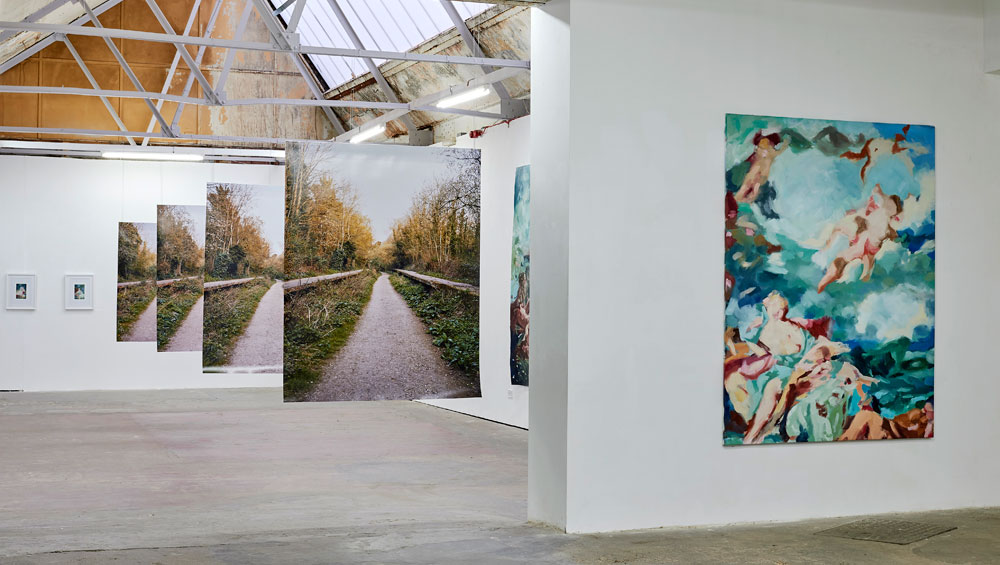
This Is What It Is to Be Happy, installation view, Paulilles Gallery, London 2019. Photo: Gabriel Kenny-Ryder.
A group exhibition with Eleanor Johnson, William Kennedy and Gabriel Kenny-Ryder
Paulilles Gallery, Copeland Park, Unit 91, London
29 May – 2 June 2019
by ANNA McNAY
In an era where mental health issues are one of the main causes of health problems worldwide per se, with major depression thought to be the second leading cause of disability, and an estimated one in six people said to have experienced some form of mental health crisis during the past week (and this data is already a few years old)1, the underlying thread of this three-artist group show, This Is What It Is To Be Happy, could not be more relevant. Timing-wise, too, short as its run sadly is, it falls right at the tail end of Mental Health Awareness Month.
Ostensibly, however, this is an exhibition about biophilia, or our innate love for the natural world – or at least that is how it is described on the press release. Painter Eleanor Johnson (b1994), whose original concept it was, has created a new series of works, Modern Bathers, which collages together fragments of Rubens, François Boucher, and Old Master paintings, with images of her friends, in pastel, idyllic, bucolic settings, which she describes as “forest bathing”.
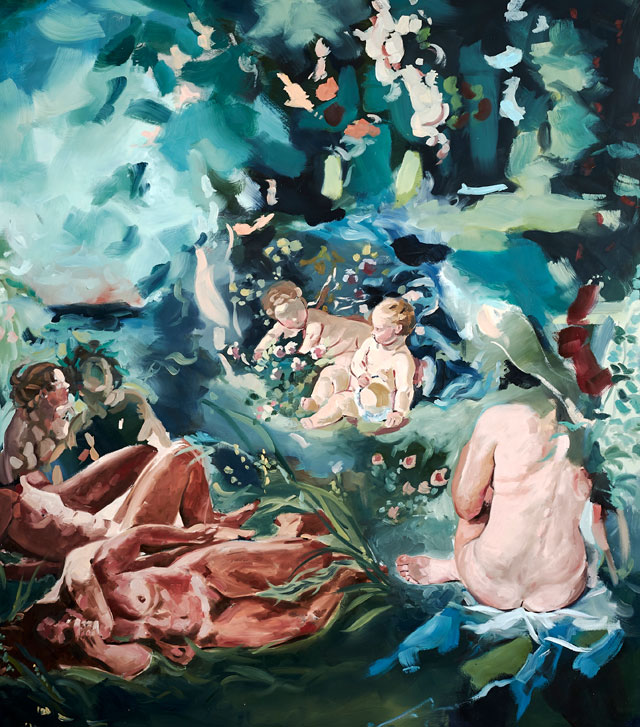
Eleanor Johnson, Forest Bathers, 2019. Oil on canvas, 200 x 230 cm. © the artist.
Photographer Gabriel Kenny-Ryder (b1993) presents panoramas, and one series of four freely hung images, of landscapes that absorb and envelop the viewer, while, simultaneously, providing stark reminders of their created materiality. It is William Kennedy (b1993), multidisciplinary artist and, here, film-maker, who freely verbalises the fact that he came along, as the third person in, and liberally interpreted this concept of inside and out, interiority and exteriority, inward and outward experience, to be a question of the mind and body, and thus, of our mental health. His frighteningly raw and visceral works, with their phantasmagorical finish, lay bare emotions many of us will have felt, but to which fewer of us will have admitted.

Gabriel Kenny-Ryder, Liminal Stretch I, 2019. Digital c-type print from single strip of medium format transparency film, 618 x 127 cm. © the artist.
Although the three artists use three different media and, on the surface of it, are treating different subject matter, the underlying connections are strong and the show hangs together as a unit, more slickly and cohesively than most professionally curated exhibitions. Kennedy’s apparently “outlier” approach to the theme of interiority and exteriority carries over and lends itself to the other two artists almost more than the more straightforward interpretation of indoors and out.
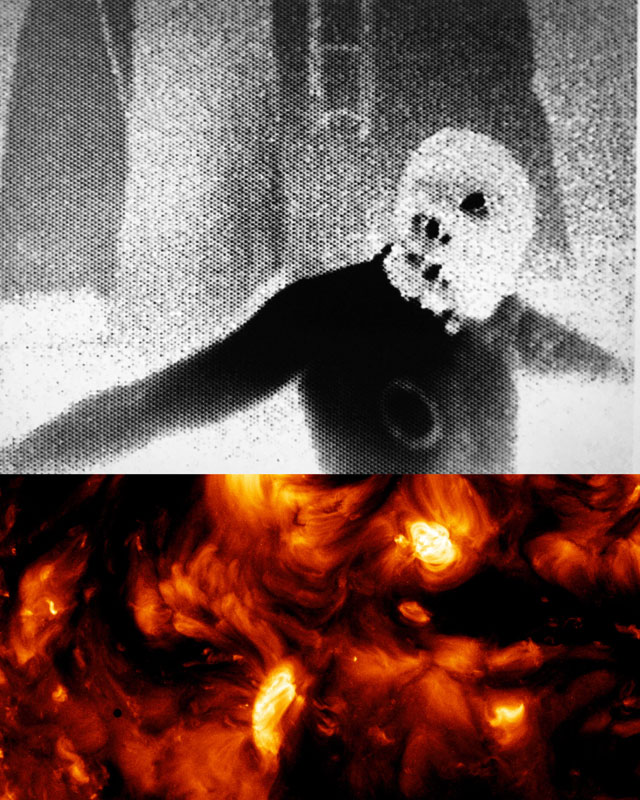
William Kennedy, when it's cold i'd like to die, 2019. Video installation, three films, single channel, colour, sound, 9 min 16 sec. © the artist.
A sufferer of anxiety, Johnson has turned to walking in nature to find peace. The choices of flowers in her new series Modern Bathers are all significant from her childhood growing up in the countryside, with her immense triptych, confronting visitors as they enter the gallery, being named Lily of the Valley, after the sweetly scented but highly poisonous plant. At the other end of the scale, she is also displaying a number of her small, abstract oil studies, which start out as preparatory sketches, although, she admits, never stay the same by the time of the finished works. These are either made directly en plein air, or else looking at old paintings, their tones and colours. She then splices the compositions with images of her friends, dropping in contemporary references, such as the (albeit well camouflaged) green nail polish in Sleepy Summer Solstice.
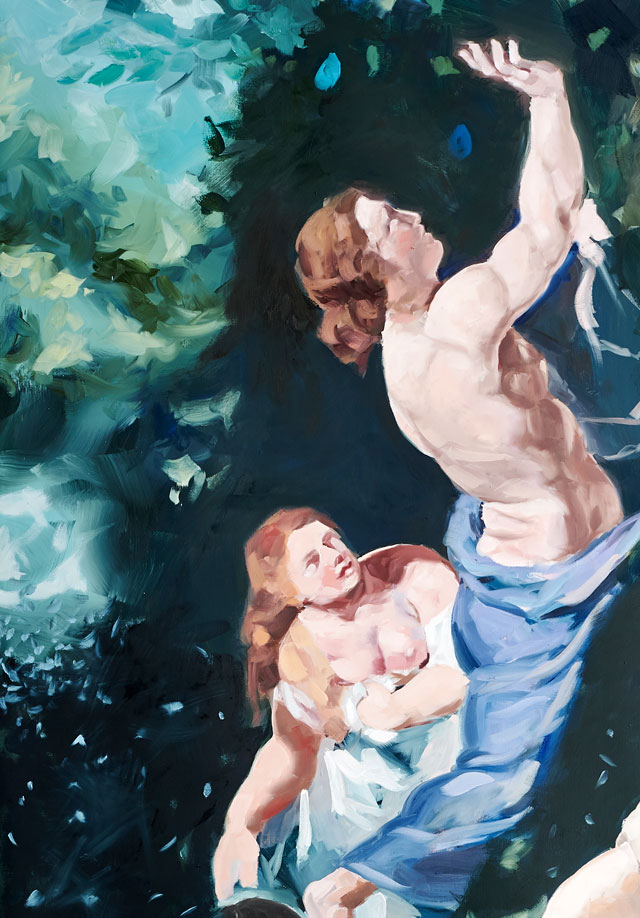
Eleanor Johnson, Lily of the Valley, 2019 (triptych, detail). Oil on canvas, 550 x 230 cm. © the artist.
In the back room, Johnson has brought out an earlier series of work, an extension of her dissertation from University College London, which dealt with body shame and eating disorders. While Modern Bathers presents myriad nude – and naked – bodies, of all sizes and shapes, Rubenesque and fleshy, seemingly content to be at one with the natural environment, the bodies in this earlier, more monochromatic series are entwined and entangled, in Jenny Saville-esque contortions, once again fat and thin, male and female, but uncomfortably and shamefully exposed, vulnerable, inside out. Looking back, Johnson recognises these works were made in a constant state of depersonalisation, and thus it comes as little surprise that the slumber in Sunstar: Any Starfish of the Genus Solaster, with Many Rays seems riddled with nightmares in comparison to the dreamlike-state of the nymph-figures in the more recent Waters of Hypnos.
Kenny-Ryder, whose superficial subject matter might be the landscape, similarly references the body, as he seeks to capture his own bodily experience and movement and invite, or, indeed, almost force the viewer to trace that same path and live that same experience with his or her own physical being. Be it by walking the path, literally, of the four sequential, suspended prints in Perpetual Wandering, or by being immersed into one of his panoramas from the series entitled Liminal Stretch, the experience is not that of simply looking at a 2D photograph.
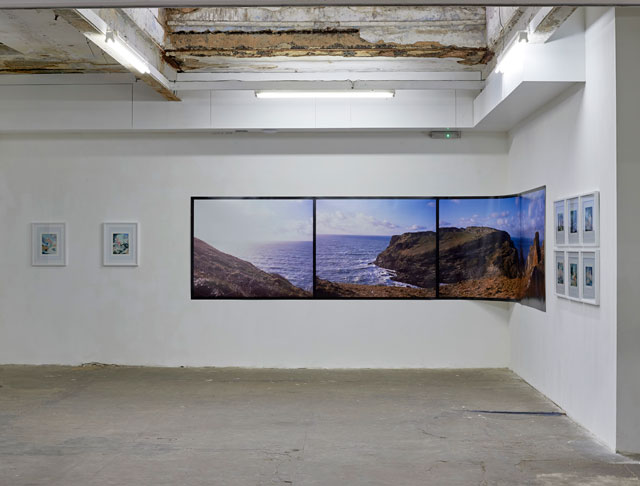
Liminal Stretch VI, 2019. Digital c-type print from single strip of medium format transparency film, 607 x 127 cm. © the artist. Installation view, This Is What It Is to Be Happy, Paulilles Gallery, London 2019. Photo: Gabriel Kenny-Ryder.
Kenny-Ryder is interested in how photography can take on a sculptural form, as well as how the viewer can interact – and be confronted by the work (achieved here through its sheer size, blown up from one roll of medium-format film, thanks to the technicians at the Royal College of Art where he studied, since most print shops could not – at least affordably – manage something this large). Initially he considered displaying the small strips of film, but something drove him to go bigger – so big you almost cannot take in everything you see in one go – teetering on the Kantian notion of the sublime. Liminal Stretch VI has been installed so as to curve around the corner where two walls meet at a perpendicular. This heightens the viewer’s sense of needing to navigate the photographic object, which neatly mirrors the dramatic and windy landscape of Tintagel, Cornwall, the legendary birthplace of King Arthur.
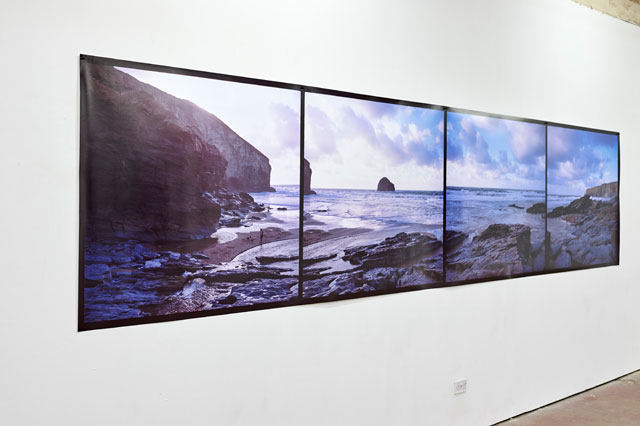
Gabriel Kenny-Ryder, Liminal Stretch V, 2019. Digital c-type print from single strip of medium format transparency film, 607 x 127 cm. Installation view, This Is What It Is to Be Happy, Paulilles Gallery, London 2019. Photo: Gabriel Kenny-Ryder.
The thick black lines between the frames in the panorama jolt the viewer back to reality, destroying the illusion, and, because of the minimal time-lapse between frames, figures are sometimes repeated: in Liminal Stretch V, for example, a girl appears in both the third and fourth frames, firstly isolated, and then reunited with her family. One becomes unsure whether it is a photograph or a strange kind of stop-motion film. The mind travels from one frame to the next, the previous one being forgotten, the next as yet unknown.
Kennedy, an English Literature graduate, speaks the least about his work. Partly because he is uncertain how much to divulge, partly because to divulge would, in many ways, destroy, or diminish, the viewer’s experience, which is built so much through his or her own response, affinity and empathy. His imagery and sound are so overwhelming, so gobsmacking, that words fail. As Kennedy describes, you are taken “from microscopic to out-of-space proportions in a matter of seconds” as you “ricochet between emotional landscapes”.
William Kennedy, when it's cold i'd like to die, 2019. Video, single channel, colour, sound, 3 min 18 sec. © the artist.
The nine minutes fly by (and this from a staunch critic of video art) and you feel as if you have been hit head on by a 10-tonne truck. You cannot move, articulate, or process. You want to stay and watch it all again, and yet, at the same time, part of you wants to be far, far away, running from the visceral horror, the violence, the blood – which, at the same time, almost inexplicably, are calming, reassuring, soothing. My first instinct (which I reined in) was to reach out and hug Kennedy, which felt disarming and peculiar, but, when he later went on to speak about the depths of despair he had been battling on the days he had made the first film, Playboy Mommy, it seems such empathy might indeed have been appropriate.
Kennedy has built his loop from three film works, made over the past few years, and put together in chronological order to portray his mental health trajectory during this time. He sees the films as projections of different forms of self, an externalising of thought patterns, landscapes of interiority. Some roles are played by friends, some by himself – like Johnson’s paintings, these films are collaged together, “made of shrapnel”, combining CGI and found imagery with his own footage, assembled in a “ramshackle” manner, pushing boundaries in the process, questioning what it is OK to externalise and share with others.
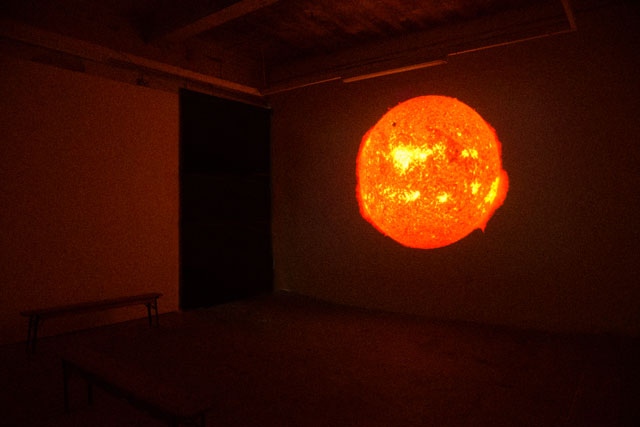
William Kennedy, when it's cold i'd like to die, 2019. Video installation, three films, single channel, colour, sound, 9 min 16 sec. Installation view, Paulilles Gallery, London 2019. © the artist.© the artist.
In Jung Death, images from a colonoscopy lead us inside the body of a possessed (or psychotic), pregnant young woman who, to a disturbing narrative, and with scenes that could trigger a seizure, takes a knife and murders her partner as he lies in bed. The final work, when it’s cold i’d like to die (which gives its title to the whole compilation), is, however, calmer. Begun before the idea for the show was proposed, Kennedy accelerated his process so as to finish and include it, offering three distinct points, or milestones, in his mental health journey. Perhaps indistinct to the viewer, who will see repeated motifs, signifiers and tropes – loaded visuals that Kennedy turns to for reassurance when things are bad – there is nevertheless an undeniable serenity to this final piece, with its (minimally) slower torrent of imagery, the silvery whites, cool blues, the awe-inspiring passage of Venus, and the trance-like music. An air of acceptance suggests the realisation that life might never be easy, that there might be few days when you wake up and feel it is a gift, but that you just have to bloody well get up and get on with it! And it is this sentiment that perhaps defines the title of the show. After all, what is true happiness but the realisation that there is no such thing?
It is a shame that this exhibition has such a short run, and I only hope it will be rerun at a later date, and/or that the artists, together or alone, will go on to gain more, well-deserved exposure.
Reference
1. mentalhealth.org.uk/statistics/mental-health-statistics-uk-and-worldwide [accessed 30 May 2019]